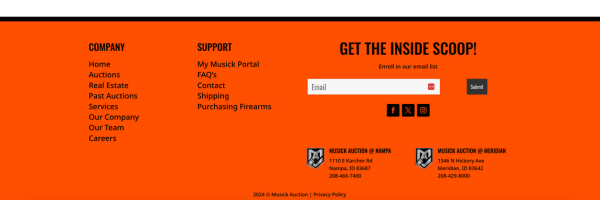3 Things For April 3rd, 2024
In-house or Outsource, Don’t Forget the Footer, Making Changes

When should you outsource your marketing and when should you do it in-house?
There is definitely a time for DIY marketing, especially when you’re just starting out and funds are tight. More than a few times, I’ve been very impressed with an owner’s drive to build their own website, create and curate content for social media, design business cards and trifolds in Canva and much more. But at a certain point, most businesses will need to find a marketing company to take over management of their website, brand, advertising, and online presence.
Here are some things to take into consideration when either you (the owner) or an employee is doing the marketing in-house.
- How much time is getting spent on marketing?
- Are mistakes/missteps happening? If so, how much time is being spent on fixing and solving them?
- Is the quality of the work where you want it to be?
- Is the marketing consistent?
- Is other “more important” work getting in the way or taking priority?
- If it’s an employee, what happens if/when they leave?
- Are you/they stuck or limited in the creative cycle?
- What opportunities are you missing simply by not knowing they exist?
Add up the cost of doing the work in-house versus what the cost would be to outsource. Then consider the ROI you’re getting from your in-house work versus the ROI you’d expect from outsourced work.
With these considerations you should be able to determine when the ROI makes sense for one or the other or a combination of both.

Elevate Your Website’s Footer!
Your website’s footer shouldn’t be an afterthought. It’s a critical component that plays a key role in user experience and site navigation. At Strategy 3, we understand the potential of this often-underutilized space. Let’s explore how a thoughtfully designed footer can enhance your website’s effectiveness:
Streamlined Navigation: Your footer is the perfect place to offer easy access to essential information. Including straightforward links to your Contact page, FAQs, and Privacy Policy can significantly improve the user journey. It’s about creating a user-centric experience that simplifies navigation and access to information.
Engagement Opportunities: Incorporating social media links and a newsletter subscription form is crucial for ongoing engagement. These elements invite visitors to connect with your brand on different platforms and keep up with the latest updates.
Consistent Branding: A footer is more than just a functional element; it’s an extension of your brand. Maintaining a consistent visual theme with the rest of your website reinforces brand recognition and contributes to a cohesive online presence.
Implementing these strategies can transform your footer from a basic utility area to a valuable asset that enhances user experience, encourages engagement, and solidifies your brand identity. With Strategy 3’s expertise, you can ensure your website’s footer is not just functional but also a testament to your brand’s attention to detail and commitment to quality.

Navigating Industry Changes: How to Pivot Your Marketing Strategies
In an ever-evolving business landscape, companies must be prepared to adapt quickly to major changes in their industry. It can happen overnight or over time, but things can and will change, and when that happens, one of the key areas that will require immediate attention is marketing.
The first step is to not overreact. When responding to a major industry change you first need to understand the nature and impact of the change, and the implications these changes could have for your company. You’ll want to review your business mission statement and ensure the vision of the company remains constant throughout the pivot.
Next, look at how competitors are responding. Analyze how these changes could affect your current business model, products, and services, and assess your existing strengths, capabilities, and resources. Involve your team and encourage open communication and collaboration.
The change in industry may necessitate a reassessment of your target market and how you address your audience. Or may require adapting products or services to meet the evolving needs and preferences of your customers. For example, let’s say your company sells a product and your marketing highlights certain benefits, such as wellness or money savings, and after a major shift in your industry, your product no longer meets these needs. This means you will need to change your marketing message to ensure your products or services continue to meet the needs of your customers differently.
This could involve revising the company’s brand identity, website messaging, imagery, and overall voice. Marketing platforms such as social media, email marketing, SEO, and content marketing will all need to pivot quickly and provide answers to why things are changing and highlight all your other benefits.
Since change could involve diversifying your product/service offerings, targeting new customer segments, entering new markets, or adopting innovative technologies, it will be important to include timelines, resource allocation, budgeting, and key performance indicators (KPIs) to track progress. A resilient brand can adapt to change, maintain customer loyalty, and continue to grow, but it will involve implementing strategies to strengthen the brand’s reputation, such as improving customer service, enhancing product quality, and demonstrating corporate social responsibility.
When it comes to marketing, maintaining a mindset of agility and adaptability—regardless of major industry changes—will help your company grow and flourish. The beauty of marketing is that it allows us to try new things, ask questions, and get responses from our customers and clients so that we can work to meet their needs. For growth to occur we must be willing to experiment, learn from failures, and pivot whenever necessary to stay ahead of the curve. Navigating the ever-evolving business landscape can be stressful, but by continuously monitoring your industry for changes, trends, and emerging technologies you’ll be one step ahead and ready for anything.

Kate Miner
(253) 219-2211
kate@strategy3degrees.com


